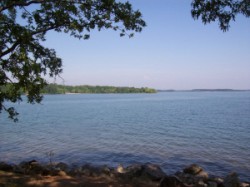2013 Year in Review: Lawmakers Discuss Savannah River Plan
 On the state and national front, two Georgia lawmakers announced the formation of caucuses to address the management of Lake Hartwell and the entire Savannah River Basin.
On the state and national front, two Georgia lawmakers announced the formation of caucuses to address the management of Lake Hartwell and the entire Savannah River Basin.
In February, State Representative Alan Powell of the 32nd District, along with State Representatives Tom McCall and Dan Gasaway announced the formation of the Savannah River Caucus. Powell said the main purpose of the caucus is to get federal lawmakers involved.
“I understand politics and as state legislators, we can write all the letters we want to, but the Corps of Engineers doesn’t have to listen to us. They don’t fall under the State of Georgia, they fall under the federal government,” Powell said. “It takes an assemblage of U.S. Congressmen and U.S. Senators. There are six or seven Congressmen in Georgia and South Carolina and two Senators. That might be enough to get the Corps to take another look at what they’re doing.”
In March, Powell introduced House Resolution 532, which calls for better controls on lake levels in the Savannah River Basin.
Then in April, U.S. Congressman Doug Collins of the 9th District, which includes Franklin and Hart counties, announced the formation of a caucus to address issues with the Corps’ management of all waterways nationwide.
“Corps projects are too often mired in bureaucracy, which means higher costs for taxpayers and delays in important public works projects. In addition, the Corps constantly undertakes new projects before competing ongoing construction. As a result, the Corps has a construction backlog estimated at more than $60 billion. Congress needs to transform the high-spending, low-transparency Corps into a responsive and fiscally responsible agency.”
Collins said his goal for Georgia is to get the Corps to develop a better water management plan for the Upper Savannah River.
“We’re not out to just bash the Corps. We’re wanting to say, ‘Do your job. Everybody else has to do their job. Do your job. Let’s get a plan for how much water can come in, how much we can retain, and how much can we make the water levels become constant because water levels are an economic issue as well,” Collins said.
A move in that direction came in September when the governors of Georgia and South Carolina came together with state and Corps officials at Big Oaks Recreation Area in Hartwell to sign an intergovernmental agreement to revise the Corps’ Savannah River management plan.
Georgia Governor Nathan Deal said it’s important that both states continue to work together.
 “We value your friendship. We value your cooperation. And we truly believe that both states that we represent have the opportunity to take advantage of what has been provided to us by God and by nature and that is the great Savannah River and the Basin that surrounds it,” Deal said. “But we know that in order to do that, we have to preserve it. We have to protect it, and we have to be responsible with the resources that have been allocated to us.”
“We value your friendship. We value your cooperation. And we truly believe that both states that we represent have the opportunity to take advantage of what has been provided to us by God and by nature and that is the great Savannah River and the Basin that surrounds it,” Deal said. “But we know that in order to do that, we have to preserve it. We have to protect it, and we have to be responsible with the resources that have been allocated to us.”
Deal cited his experiences dealing with the ongoing Lake Lanier water discussions with Alabama and Florida and said praised the foresight of lawmakers in both states for beginning talks before ordered to by the courts.
Meantime, South Carolina Governor Nikki Haley also praised the summit and the efforts of state lawmakers to work together.
Haley said while South Carolina may be in competition with Georgia in some areas, the two states must work together when it comes to saving the resources of the Savannah River.
 “When you look at the water issues that we’re both dealing with in both states, the reason why I so appreciate you all getting together now is that we don’t need to wait until we have a crisis to deal with it,” Haley said. “What we do need to do is have a business plan; always knowing that we are ready for whatever happens to either one of our states, knowing that when one state is in need, the other is going to be there.”
“When you look at the water issues that we’re both dealing with in both states, the reason why I so appreciate you all getting together now is that we don’t need to wait until we have a crisis to deal with it,” Haley said. “What we do need to do is have a business plan; always knowing that we are ready for whatever happens to either one of our states, knowing that when one state is in need, the other is going to be there.”
Just before signing the study agreement, Colonel Tickner said the study will come in two phases.
“The result of this interim study is designed to study our most recent drought contingency plan,and will be based on the most recent drought record in the basin, which you all lived through from 2007 – 2009,” Tickner said. “Ultimately, the results of this part of the study will answer two pressing questions: how long can we reduce the outflows at Thurmond Dam during drought conditions and how long can these minimum outflows be sustained before significant damage to the economies and environment.”
Tickner said the first portion of the study should last over a year.
Tickner said the second phase will be the full comprehensive study, which he said will provide data and help make recommendations on future water management.
